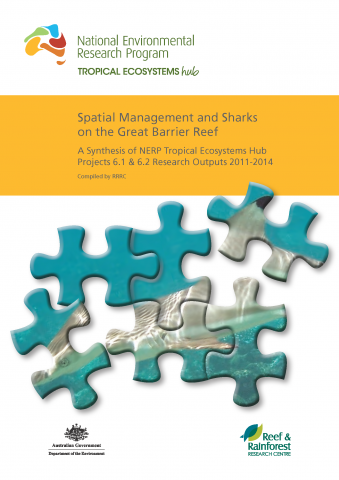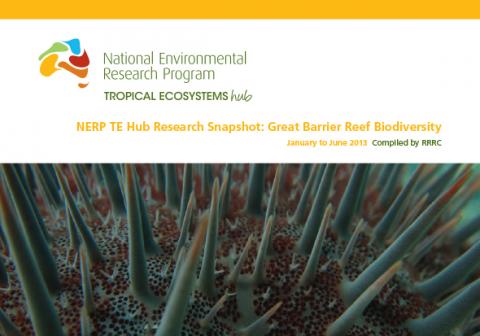Resources
 Donnelly, R., Yates, P., Schlaff, A., Espinoza, M., Matley, J., Ledee, E., Currey, L., de Faria, F., Moore, S. (2015) Spatial Management and Sharks on the Great Barrier Reef.
Donnelly, R., Yates, P., Schlaff, A., Espinoza, M., Matley, J., Ledee, E., Currey, L., de Faria, F., Moore, S. (2015) Spatial Management and Sharks on the Great Barrier Reef.
 The Great Barrier Reef Outlook Report 2009 is a stock-take of the Great Barrier Reef, its management and its future.
The Great Barrier Reef Outlook Report 2009 is a stock-take of the Great Barrier Reef, its management and its future.
The aim of the Outlook Report is to provide information about:
- The condition of the ecosystem of the Great Barrier Reef Region (including the ecosystem outside the Region where it affects the Region);
• Social and economic factors influencing the Great Barrier Reef ecosystem;
• Management effectiveness of the Great Barrier Reef; and
• Risk-based assessment of the long-term outlook for the Region.
The Report underpins decision-making for the long term protection of the Great Barrier Reef. It was prepared by the GBRMPA based on the best available information and was independently peer reviewed. Many people contributed to the development of the Outlook Report including:
• Australian and Queensland Government agencies
• Leading Great Barrier Reef scientists and researchers
• Industry representatives
• Advisory committees
• Members of regional communities and the public.
The publication of an Outlook Report was a key recommendation of the review of the Great Barrier Reef Marine Park Act 1975. A report is to be prepared every five years and given to the Minister for Sustainability, Environment, Water, Population and Communities for tabling in both houses of the Australian Parliament.
The Great Barrier Reef Outlook Report 2009 is the first of these reports.
 A snapshot of the research progress within the Great Barrier Reef Biodiversity node for January to June 2013.
A snapshot of the research progress within the Great Barrier Reef Biodiversity node for January to June 2013.
 A snapshot of the research progress within the Great Barrier Reef Biodiversity node for July to December 2013.
A snapshot of the research progress within the Great Barrier Reef Biodiversity node for July to December 2013.

This project will determine the movement and habitat use of large predatory fishes such as sharks and coral trout in reef and coastal environments of the Great Barrier Reef. Individual fish are fitted with acoustic transmitters that are detected by an array of acoustic monitoring stations. These monitoring stations record the presence and movement of fish between the coast and the reef, and between reefs. Predator presence and movement will be integrated with habitat mapping and environmental monitoring data to identify factors that lead to changes in movement patterns and to define any preferred locations or conditions that can be targeted for conservation or management.

Reviews in Fish Biology and Fisheries
Kessel, S.T., Cooke, S.J., Heupel, M.R., Hussey, N.E., Simpfendorfer, C.A., Vagle, S., Fisk, A.T. (2014) A review of detection range testing in aquatic passive acoustic telemetry studies. Reviews in Fish Biology and Fisheries. 24 (1), 199-218 [doi: 10.1007/s11160-013-9328-4].

Currey, L M., Heupel, M.R., Simpfendorfer, C.A., Clark, T.D. (2013). Blood lactate loads of redthroat emperor Lethrinus miniatus associated with angling stress and exhaustive exercise. Journal of Fish Biology. 83 (5), 1401-1406 [doi: 10.1111/jfb.12216].

Udyawer, V., Cappo, M., Simpfendorfger, C.A., Heupel, M.R., Lukoschek, V. (2014) Distribution of sea snakes in the Great Barrier Reef Marine Park: observations from 10 yrs of baited remote underwater video station (BRUVS) sampling. Coral Reefs. 33 (3) 777-791 [doi: 10.1007/s00338-014-1152-3].

Marine Ecology Progress Series
Heupel, M.R., Simpfendorfer, C.A. (2014) Importance of environmental and biological drivers in the presence and space use of a reef-associated shark. Marine Ecology Progress Series. 496, 47-57 [doi: 10.3354/meps10529].

Journal of Experimental Marine Biology and Ecology
Currey, L.M., Heupel, M.R., Simpfendorfer, C.A., Williams, A.J. (2014) Inferring movement patterns of a coral reef fish using oxygen and carbon isotopes in otolith carbonate. Journal of Experimental Marine Biology and Ecology. 456, 18-25 [doi: 10.1016/j.jembe.2014.03.004].


